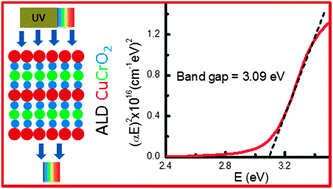Atomic layer deposition of transparent semiconducting oxide CuCrO2 thin films
Abstract
Atomic layer deposition (ALD) is a vital gas-phase technique for atomic-level thickness-controlled deposition of high-quality thin films on various substrate morphologies owing to its self-limiting gas–surface reaction mechanism. Here we report the ALD fabrication of thin films of the semiconducting CuCrO2 oxide that is a highly prospective candidate for transparent electronics applications. In our process, copper 2,2,6,6-tetramethyl-3,5-heptanedionate (Cu(thd)2) and chromium acetyl acetonate (Cr(acac)3) are used as the metal precursors and ozone as the oxygen source. Smooth and homogeneous thin films with an accurately controlled metal composition can be deposited in the temperature range of 240–270 °C; a post-deposition anneal at 700–950 °C in an Ar atmosphere then results in well crystalline films with a delafossite structure. Electrical transport measurements confirm the p-type semiconducting behavior of the films. The direct bandgap is determined from UV-vis spectrophotometric measurements to be 3.09 eV. The observed transmittance is greater than 75% in the visible range.


 Please wait while we load your content...
Please wait while we load your content...